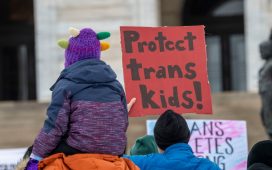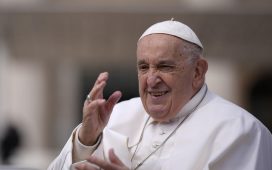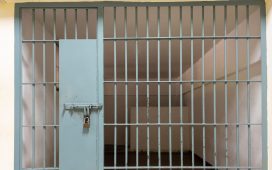Peter and his friends were on the move in the streets of Hong Kong. They cut through the sooty midday heat, jostling and joking in skateboarding sneakers, making their way past tattered industrial buildings, printing presses, and garages. They were three young men in a crowd of thousands of people, snaking through the streets and along the waterfront.
They marched with the crowd and shouted slogans, but to Peter and his friends the demonstration was just an opening salvo. Last Saturday, as usual, they had come to fight. Tight scarves masked their faces, and trekking poles jutted from their backpacks, a strategic choice—the retractable sticks pack a hard blow, but they’re light to carry and not technically weapons.
“Hong Kong police!” someone screamed, opening a call and response.
“Know the law but break it!” Peter hollered with the rest of the crowd, raising his fist toward the sky.
For months, Hong Kong has been shaken by unrest that has spread across neighborhoods and class divides, attaching to one grievance and then another, sweeping as many as two million people into the streets. This particular march was organized against the smart lampposts that are being installed around the city, which protesters fear will be used for surveillance; it was also the latest vessel for the free-floating rage against Hong Kong’s police and politicians and, underpinning it all, the central government in Beijing.
The trouble began earlier this year, when Hong Kong’s government proposed a bill that would allow fugitives in the city to be extradited to mainland China. In a city already grappling unhappily with the privileges and perils of its standing as a special administrative region, the spectre of Hong Kong residents vanishing into the mainland’s opaque police and court system provoked immediate outrage. A groundswell of protests turned violent on June 12th, when street battles erupted between police and activists. The bill was then suspended indefinitely, but that wasn’t enough to quell public anger. The protesters have repeatedly returned to the streets and train stations and even Hong Kong’s airport, demanding a slate of reforms, including the total withdrawal of the extradition bill, an investigation into police use of force, and the right to elect leaders without the influence of Beijing.
Peter, who is twenty-two and recently earned a university degree in business, has a lanky frame and bushy hair that tumbles forward over his eyes. He lives with his parents and works part time as a waiter. At least, that was his life before the protests. Now he’s the de-facto leader of a cell of brawlers, none of whom knew one another before meeting in the streets this summer. They consider themselves front-line defenders of their home town and the tip of the spear against Chinese authoritarianism.
“We’re slapping China in the face,” Peter told me. “At first, I didn’t want to use violence, but I came to think that, without violence, it’s useless.”
The marchers fanned out to fill the empty road, walking past the Wai Yip Street substation and down along the edge of Kowloon Bay. The gathering was diverse and relatively mellow—senior citizens and a few families with baby strollers meandered along; packs of masked students walked among organizers chanting into loudspeakers. Volunteers lined the route, passing out bottles of water and packets of crackers.
Peter and his friends were full of testosterone and swagger, their limbs jerking with energy. They tripped along so fast that they reached the front of their group, with organizers calling out to them to wait, to give the others a chance to catch up. “We’re getting separated!”
The chants turned to Hong Kong’s chief executive, Carrie Lam, who is easily the figure most reviled by the pro-democracy movement.
“Carrie Lam!”
“Step down!”
“Carrie Lam!”
“Go to hell!”
Peter’s friends were whispering among themselves. Peter explained the problem: one of the guys was carrying a new identity card, rumored to contain a chip that can be used to identify and track people down. They were looking for a piece of foil to wrap the card, believing that this might protect him. But the shops and restaurants had closed in anticipation of unrest.
“If they wanted to, they could have arrested you ages ago,” Peter pointed out.
The teen-ager was not convinced. He kept dashing off, ten feet in one direction and then another.
“You’re an idiot,” Peter said. “I reminded you to buy some before.”
The protesters reached the end point of the march, a small park, and milled around on the grass. With the formal event finished, the families and unmasked marchers began to leave. The younger, more radical demonstrators remained, typing furiously into their phones or clumping together for muttered consultations. Something was going to happen, but they weren’t sure what.
Peter jabbed impatiently at his phone, scanning the encrypted-messaging groups that the protesters use to coördinate their actions. Virtually every aspect of the pro-democracy movement—from press announcements to strategic questions and the fighters’ plans and rendezvous points—is coördinated on the encrypted-messaging app Telegram. Peter was getting information from scouts who move around the perimeter of the protests, climbing onto rooftops to track the police.
Peter’s eyes crinkled in a grin; he showed his friends a picture of a riot-police van.
“They’re waiting for us.”
Hong Kong’s troubles will likely deepen. Hong Kong police have begun rounding up pro-democracy leaders, and officials have hinted at the possibility of imposing emergency law. China, meanwhile, has been ostentatiously moving troops around on the edge of Hong Kong and inside the city. China Daily, the official English-language newspaper warned this week that Chinese soldiers in Hong Kong won’t “sit on their hands” if the city becomes less stable.
“They have a lot of people who can do the dirty work for them,” a protest organizer named Bonnie Leung told me. “They don’t care if we’re killed. They don’t care if we’re seriously injured. If it’s the Army or not the Army, there’s no real difference.”
Leung, who is thirty-two, is a spokeswoman for a protest group called the Civil Human Rights Front. Leung is not herself a fighter; she doesn’t carry weapons or move to the front of the crowd to confront riot police. But, like many members of the democracy movement, she believes that the militants are both strategically necessary and morally noble. She calls fighters like Peter “the brave.” “We saw them risking their lives,” Leung told me. “We are indebted to those people. They were really heroic.”
A short, serious woman with glasses and hair chopped short, Leung had suggested that we meet in Admiralty, where a cluster of government headquarters forms Hong Kong’s bureaucratic nerve center. A short, serious woman dressed all in black, she pointed out the barricades around the Central Government Complex; the angry graffiti scrawled on the Legislative Council; the soldiers standing guard in the Chinese People’s Liberation Army building. The buildings were her way of communicating what had happened, I realized; she was offering me a tour of an uprising.
All of Leung’s stories circled back to the same day: June 12th. She described watching in horror while police beat demonstrators with batons and pro-Beijing legislators cowered out of sight. But the clashes were crucial, she insisted, because they physically blocked lawmakers from reaching the Legislative Council to vote on for a second reading of the extradition bill.
“We realize now that, if there were no brave protesters, that bill would have passed,” she said. “With us alone, we’d have been hopeless.”
We wandered into a shopping mall and stopped in a café for tea. Leung stared into her cup and mentioned that date again: June 12th. “Actually, that’s my birthday,” she said abruptly. “I saw people risking their lives trying to save Hong Kong on my birthday. It made me realize I can never celebrate my birthday again.”
Her voice cracked and suddenly she was weeping. She took off her glasses, fished a worn scrap of fabric from her bag and scrubbed at her eyes. “The brave can’t give interviews, of course,” she sobbed, “so I force myself to do it. If we stop, it’s Hong Kong that will die.”
Leung’s personal story is cut straight from the popular mythology of Hong Kong—a place where mainland refugees could start fresh, flourishing with the help of a dynamic economy and greater political freedom. Her grandparents were farmers who fled poverty in the province of Guangdong and wound up living in what was then a bustling, British-ruled port city. Her father drove a taxi; her mother worked as a cleaner. Leung grew up in a gritty public-housing estate.
At home, no one ever spoke about politics except to discourage their discussion. Leung’s mother warned her against talking publicly about the events of 1997, when Hong Kong passed from British colonial rule to rejoin China as a special administrative region. When the family travelled to Guangdong to visit relatives, her parents forbade her to bring any newspapers. “They told me, ‘There are some things they don’t want to see in China,’ ” Leung recalled.
And yet she dreamed of a life in politics. As a child, she loved to watch Chris Patten, the last British governor of Hong Kong. She was mesmerized by this man who ate Hong Kong egg tarts and kissed babies, who spoke beautiful English and seemed to inspire a particularly harsh vitriol from critics in inspired torrents of mainland China. She considered Patten a force of democratization, and she dreamed of following him into politics. Leung spent long hours over her books and qualified for a subsidized place at a university, becoming the first person in her family to study beyond secondary school.
She is the creation of a city’s possibilities, but, at the same time, Leung is stuck in place. Like many adult children in Hong Kong, she still lives with her mother in the same flat she’s called home since childhood. They have two rooms and four hundred square feet of space. “Living in public housing—we’re not proud of it,” she said. “I’m the only one who supports my family.”
We finished our tea and headed out of the café. A man stood up from his table to stop Leung. “Excuse me, I don’t know you,” he said. “But I want to thank you for what you’re doing for the people.”
She shook his hand, flustered. Her backpack, printed with pictures of Woody, the cowboy from the “Toy Story” movies, slid clunkily off her shoulder.
“I’m not really so well known,” she insisted as we walked away.
The sky outside had paled as night drew near, and commuters jammed the sidewalks. As Leung and I walked through the central business district, gaudy lights flickered to life in the windows of luxury shops—Louis Vuitton, Armani, Saint Laurent. Illuminated elevators glided up and down the spines of office buildings. Doormen stared into space as crowded buses hissed along the curbs.
Here is the thing about the Hong Kong protesters that’s hardest to convey: to spend time with them is to immerse oneself in a world that is dreamlike, a collective exercise that is almost delusional—that would, indeed, be delusional, except for the fact that the participants are themselves aware that they are suspending disbelief. To many of them, the mainland looms as a place that is both unthinkably powerful and morally inferior; a vast, drab landscape of casual brutality. And yet, despite the fear and loathing, China remains both Hong Kong’s origin and its destiny.
Everyone knows the truth, but few like to dwell on it: Hong Kong is temporarily suspended in a transition between its past as a British colony and its future as a Chinese city that may or may not retain the liberties it now enjoys. This particular scrap of time—a fifty-year stretch built into the handover deal—will expire in 2047. When that date arrives, what will become of all the fights that have absorbed the city’s demonstrators so wholly—the fight against mainland education, mainland justice, mainland identity? The rulers in Beijing will be the ones who answer.
This understanding is implicit in everything this generation does. It emboldens students to rip up the bricks of the street and hurl them at the cops. It makes the likelihood of prison or injury less relevant. A spate of suicides has punctuated the street actions, and references to the “martyrs” are woven through speeches and slogans. Activists boast that their biggest turnout was “two million plus one,” a reference to a young man who fell to his death while displaying a protest banner on the eve of a march. More suicides followed.
When you ask the demonstrators about their endgame, they retreat to grandiose fatalism. At least we won’t go down without a fight, they say. History will reflect that we stood up. “In a sense, Hong Kong people are resisting the inevitable: a wave of repression arriving in Hong Kong,” a veteran protester named Johnson Yeung told me. At twenty-seven, he has been arrested five times for his activism. “We’re just trying to turn the doomsday clock back several minutes.”
From the park, Peter and his friends strode up a wide boulevard to the Ngau Tau Kok police station. This was it—the fortress of the enemy. Peter perched on a road barricade and pulled out his gear: a padded helmet to withstand blows of the batons; industrial goggles and a mask known as a “pig snout” to protect against tear gas. He was already wearing synthetic arm coverings, like opera gloves with the hands chopped off, to shield his skin from pepper spray and tear gas. Now he tucked tiny vials of saline into his sleeve to wash tear gas from his eyes.
Around them, the crowd grew thicker and deeper—word of this second gathering was spreading on Telegram. Soon the road and all visible bridges and overpasses were packed with demonstrators, most of them wearing the protest uniform of a face mask and black shirt, all of them staring down the police station.
“What are you discussing?” Peter screamed at the blank building. “How much more time do you need?”
Two masked men rushed the police station, vaulting over a traffic barricade and advancing with a can of spray paint. “Fuck the popo,” they scrawled on the station wall, before dashing back to join their cheering comrades.
A few policemen emerged, gravely examined the fresh graffiti, and then retreated back behind the walls.
The ragged roar of the crowd was punctuated by an eerie clanging of makeshift percussion: metal bowls on the stems of street signs; bamboo sticks on plastic barricades; rock on rock. Someone was carrying a speaker through the crowd, blasting “Fuck the Popo,” a protest anthem by the Cantorapper JB.
A roar erupted from the demonstrators gathered on a nearby roof: riot police were advancing shoulder to shoulder down the road by the police station. The screaming got louder and less coherent. Someone was yelling into a loudspeaker.
The police use flags to communicate. First yellow, then red—a final warning to disperse. When the black flag goes up, it means tear gas is next. The black flag went up. “Get out of here, run!” the demonstrators kept shouting.
The situation fell apart slowly, and then all at once. The police pushed forward a little and then fell slightly back; the demonstrators shouted and ran a short distance and then returned.
Then, at last, the crisis erupted: the police shot tear-gas cannisters and the fighters hurled back bricks and rocks and any other projectile they could grab, and everyone was choking and running to escape or to fight. Peter pulled out his stick and rushed forward to join the battle, disappearing into the fog of gas and scrambling figures in black.
The fighting raged for hours. Peter and his friends brawled with the police, staging what they call “hit and runs,” getting in their blows and taking them, too. Rolling fogs of tear gas wafted in the breeze. As Peter disappeared into the clashes, I followed some fighters first to one deserted shopping mall, then another. By this time, it was dark, and the scene looked more like guerilla warfare than a street demonstration, with packs of fighters slipping through tight-packed urban landscapes to evade or surprise the police. At the shuttered Kowloon Bay Station, angry messages were freshly spray-painted in black—the protesters were enraged that the transit company had coördinated with police to cut train service to the recent protests.
A nearby McDonalds was, improbably, still open. Cathy Chan and Selina Mok, both twenty-year-old university students, perched at a communal table. Friends since high school and comrades in the demonstrations, they sipped their sodas and stared grimly at their phones. They’d just come in off the streets and were watching live footage of the fighting.
Before the demonstrations erupted, Chan and Mok spent their weekends exploring the streets of Hong Kong or visiting karaoke lounges. Now they poured all their spare time into the protests, and Mok was thinking about joining a student boycott when classes resumed in September. Their activism, particularly the suggestion of skipping school, infuriated their parents. Mok’s father works as a security guard; Chan is the daughter of a night-club waitress and a truck driver. Neither family is sympathetic to the protesters; Mok’s parents are staunchly pro-government.
Mok, a soft-spoken young woman with long bangs that fell over her eyes, said that she and her father are no longer speaking. “My parents are saying, ‘They should just kill the protesters,’ ” she said. “It’s very hard for me. I tell myself, ‘Just ignore them.’ ”
“My parents don’t even know how to go onto the Internet,” Chan said. “They just watch government TV.”
“Whenever I watch the news about the protests, I become very sad,” Mok said. “I’m also very angry. I feel helpless.”
“We’re quite hopeless,” Chan agreed. “But we’re still trying to fight for our future. At least we’re doing something we won’t regret later.”
At 8 P.M., Peter and his friends were still getting texts to join another clash with police, but they were exhausted and hungry. They fled on foot until they reached a subway station, jumped the turnstiles, and rode to another station, where they finally rested, dropping cross-legged onto the platform, gulping from water bottles, and chewing on Mentos. Peter had texted me to meet him there, and he wasn’t alone—the platform was buzzing with protesters meeting friends whom they’d lost in the melee. The trains slid in and out, disgorging packs of black-clad youth who trailed through the station like weary soldiers, clapping one another on the shoulder and trading brief greetings.
Peter sported a fresh, swollen bruise over one eye.
“The barricades we built didn’t really work,” one of the guys said. “The riot police walked right through them.”
“I’m so tired,” Peter groaned. “And tomorrow we have to fight again.”
A couple of seniors paused on their way off the train. They walked slowly; their faces were puckered with concern. “Please go home, boys,” the woman said. “It’s getting late. We’re worried.”
“Yeah, yeah,” the young men grumbled. “We know.” Peter’s father had already called him, to make sure that he was O.K. “He said, ‘Take care of yourself, don’t get hurt,’ ” Peter told me.
A group of young men in black came off a train and asked Peter, “Is it safe?”
“It’s safe,” Peter said. “We’re going to rest a bit and then join you later.” Another passing fighter in black offered them more water. Peter glanced around the train platform with sudden amusement. “Hong Kong used to be a really cold city,” he said.








